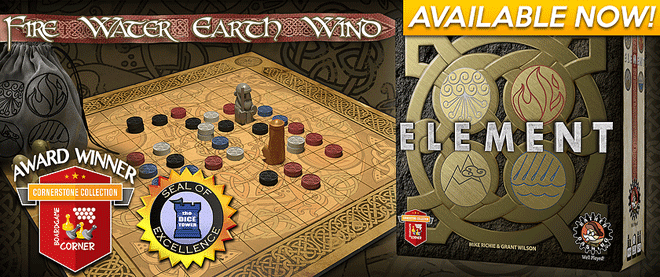
March Game of the Month – Element
The Game of the Month series highlights one of the many games in our libraries at Ravenwood Castle and the Malted Meeple. We will briefly describe the game, how to play it, and why we like it. The Game of the Month is written by the Meeple’s Head Game Master – and former Ravenwood Innkeeper – Karington Hess.
March’s Game of the Month, Element, comes from our friends at Rather Dashing Games. In Element, players must use the primordial forces of nature – earth, water, fire, and air – to trap their opponent’s Sage. But each element behaves in its own unique way. You will need to master all four elements to restrict your opponent’s movement and win the game. But beware: each stone you place will affect future turns and may aid your opponent’s strategy as much as your own.
To begin a game of Element, players choose a Sage to represent them and place their Sage on its starting position on the board. For a two player game, the Sages are placed in the middle of the board. In a three to four player game, Sages are placed on one of the four element symbols on the board. During your turn, you may draw up to four element stones from the bag. Each element stone affects the board differently and has its own unique rules. When placing an element stone you may choose to replace an existing stone following the rule of replacement. Fire Stones may replace Wind Stones, Wind Stones may replace Earth Stones, Earth Stones may replace Water Stones, and Water Stones may replace Fire Stones.
Each element has its own special rules you must follow when placing an Element Stone, giving each element its own unique feel and strategy. When you place a Fire Stone adjacent to another Fire Stone, the fire spreads and you place an additional stone on the opposite side of the stone you just placed. When you place a Water Stone adjacent to another Water Stone, it forms a river and flows a number of spaces equal to the number of stones in the river and carries the other Water Stones in the river along with it. Earth Stones block movement and a player can stack an Earth Stone on top of another Earth Stone to form a Mountain. Any Earth Stones connected to a Mountain become a Range and restrict diagonal movement and cannot be replaced by an Air Stone using the rule of replacement. Fire, Water, and Earth Stones block the movement of Sages. Air Stones do not restrict Sage movement and instead allow Sages to jump over them and land safely on the other side without using any valuable movement points. Air Stones may also be stacked on top of one another to form a Whirlwind, allowing a Sage to jump multiple spaces for free. On your turn, you may also move your Sage one space plus an additional space for each stone you did not draw this turn. The game ends when you have captured your enemy Sage by encircling him with element stones.
This unique strategy game may at first glance seem to be a simple pure-strategy game, but it is so much more. The rules to the game are deceptively simple and each game played is vastly different from the last. It is a flawless blend of simple, but satisfying game play. Each of the elements add their own delicious flavor to the mix, making this game a unique yet elegant strategy game. The careful balance of strategy, tactics, and luck make this game one of my new personal favorites! Check it out next time you visit!


 Quoth the Raven
Quoth the Raven